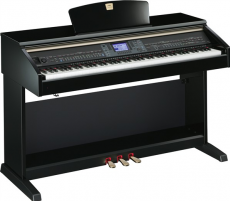
As mentioned in my last article on the magnificent instrument that is the piano, there has been a gradual trend over the last decade towards non-acoustic variants of the instrument. While in previous decades such as the 70s and 80s, music started to use electric variations of the piano, this was more in relation to taste than anything else. Synths were used, which are played like a piano, but can create a wide variety of sounds, and these gave 80s music its very artificial feel, however at the time this was simply a popular sound for the music, rather than for practical reasons. These days however, it is simply much easier to use non-acoustic instruments, as the volume can be adjusted more easily, they can be smaller and more portable, and they can be played using headphones. Also, in the case of pianos, they do not have to be retuned.
Electric pianos do use the conventional strings, but they are much smaller, and are in a much tighter space so they cannot resonate as loudly. They therefore make a much quieter sound, which is then amplified, as the sound from an electric guitar string would be. Electronic pianos on the other hand, are those where no acoustic element is used, and hitting the string merely produces a simple synthesised sound from a computer. Digital pianos are the most popular non-acoustic model today, and they use sampling technology to produce the sounds from the piano, which involves previous recordings of acoustic piano notes being played, rather than fully synthesised sounds. Some people confuse digital pianos with keyboards, but the two are actually quite different instruments. Keyboards are considerably shorter than digital pianos, usually having either 61 or 76 keys, as compared to the full 88 keys that are found on pianos. Equally, keyboards generally use a backing style, which is controlled by the chords played in your left hand, while pianos use the left hand to create its own rhythm. Keyboards also do not tend to use pedals in the same way as a digital or acoustic piano would. They are generally considered slightly simpler to play, but they have their uses, as they are much better at replacing a whole band than a piano can on its own, being able to mimic a greater variety of voices, and being able to easily add style and substance to a song.
The piano is increasingly becoming popular again with artists such as John Legend and Gary Barlow who use them as their main instrument. This is nice to see, as some of my favourite more classic artists, such as Billy Joel and Elton John, also centred their music on the instrument, and it’s a style that really speaks to me. The increased popularity of digital equivalents to the instrument should also have some effect on the instruments popularity as a whole, and hopefully it will lead to people outside the main musical circle also appreciating the instrument as much as it deserves.
There are so many reasons that the piano maintains its popularity today. It’s elegant, great for composing, and it’s become somewhat of an iconic sound. Whatever the reason is, I hope that this instrument remains at the centre of music for years to come. If you are looking to learn an instrument, this one is certainly worth learning. Perhaps it’s not seen as ‘cool’ like the guitar is, but in the music industry, this instrument is actually probably the most useful and most needed instrument around.
Image from: http://static.musicroom.com/img/c/f/CVP501PE.jpg

0 Comment:
Be the first one to comment on this article.